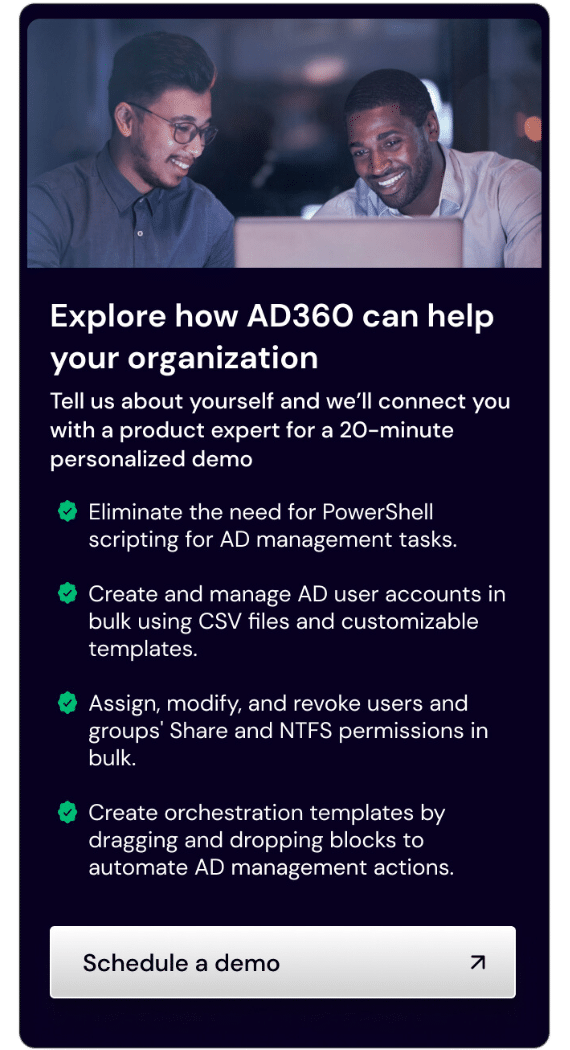
If “search is slow” keeps popping up, the root cause is usually query shape and whether the directory can answer it with an index. In Active Directory, the right index can cut a search from seconds to milliseconds—but the wrong one just bloats NTDS.dit.
Internal links throughout point to Windows-Active-Directory.com references (WAD), and external links go to Microsoft’s first-source docs.
Why this matters now
Modern identity stacks hammer AD with real-time lookups—device posture checks, privileged access workflows, HR syncs, and legacy apps. These workloads depend on repeatable, efficient searches. Indexing is the closest thing AD offers to a performance dial without rewriting every client.
Definition: An AD index is a per-attribute structure that lets a domain controller find objects matching a filter without scanning the whole partition. You enable it by setting bits on the attribute’s searchFlags in the schema. The baseline bit to “make it an index” is 0x1. See Indexed attributes and searchFlags.
If your environment spans multiple domains, you’ll often query the global catalog (verify GC role) to get a forest-wide answer fast.
What most people know—and what’s missing
You’ve heard “index frequently queried attributes.” True but incomplete. Indexes help reads and tax writes. Any time the attribute changes, the index updates. Expect database growth and some replication knock-on during build.
Not all indexes are equal. AD supports basic, containerized, tuple (leading wildcard), ANR, and a flag that improves virtual list view (VLV) sorting/paging. Each exists to answer a different query shape.
Client behavior matters: paged queries can use only one index for evaluation. That innocent detail can turn a “well-indexed” filter into an expensive one. See Microsoft guidance on Event 1644 analysis.
Need a refresher on LDAP itself? Start with WAD’s introduction to LDAP or the AD with LDAP integration primer.
First principles: how AD decides to use an index
Think of AD’s search pipeline as scope → filter → projection. Scope (base, one-level, subtree) narrows the candidate set. Filter clauses run left-to-right with short-circuiting. AD seeks an indexable clause early and prefers the clause that shrinks the candidate set most. Attributes to return are projected; server-side sorting and VLV modify the plan and may require a specific index.
Scope well.Use OU-scoped searches when possible. Review your site topology to keep queries local. See WAD’s Active Directory sites overview.
Filter smart.Put the most selective, indexable clause first. If you must page, remember AD can apply only one index during a paged search.
The indexing mechanisms compared
1) Basic per-attribute index (searchFlags 0x1)
Use when: Filters frequently test equality or prefix on one attribute (e.g., employeeID=12345, samAccountName=ALICE*).
Pros: Big impact with a small schema change; AD builds the index in the background.
Cons: Write amplification and DB growth; poor selectivity (e.g., booleans) brings little benefit. Learn more.
2) Containerized index (0x2)
Use when: Searches are OU-scoped (helpdesk device lookups under a specific container).
Pros: Accelerates one-level and subtree searches within containers.
Cons: Less benefit if most queries target the domain root. Flag reference.
3) Tuple index (0x20)
Use when: You must support leading-wildcard or “contains” searches like (sn=*mith) or (cn=*svc*).
Pros: Removes the classic penalty of a leading *.
Cons: Larger index; plan disk accordingly. Flag reference.
4) ANR (ambiguous name resolution) (0x4 + 0x1)
Use when: Global address-book style searches—users type “jeff” and find Jeff Smith by givenName, sn, displayName, etc.
Pros: A single (ANR=…) filter fans out across the ANR set for human-friendly search.
Cons: Can return surprising matches; expanding ANR increases work for every ANR search. Remarks.
5) VLV-helping index (0x40)
Use when: Your application uses server-side sorting with the VLV control (address books, portals showing thousands of rows).
Pros: Greatly improves VLV performance; sometimes required when the sort control is critical.
Cons: Another index to maintain—confirm the client actually sends VLV and sort controls. MS-ADTS VLV, How to search using VLV.
6) Global catalog participation (PAS)
What it is: Not an index per se, but forest-wide replication of chosen attributes to GC servers (ports 3268/3269).
Use when: You search across domains or want to resolve objects and read common attributes from the GC alone.
Trade-off: Faster forest-wide lookups vs. more replication and disk use on GCs. Start with WAD’s global catalog guide and replication basics.
The straight-technical core: from “slow search” to shipped fix
This is the copy-pasteable runbook. It assumes schema admin rights for changes.
0) Pre-checks
- Ensure clients hit site-optimal DCs, not hair-pinning across the WAN. Review sites and services.
- Confirm paging defaults; oversized pages can hurt concurrency. If you must page, remember AD can use only one index during evaluation.
- If lookups cross domains, ensure the target attributes live in the GC.
1) Capture evidence with Event 1644
- On a test DC, set Field Engineering logging to 5:
reg add "HKLM\SYSTEM\CurrentControlSet\Services\NTDS\Diagnostics" /v "15 Field Engineering" /t REG_DWORD /d 5 /fOptional thresholds:
HKLM\SYSTEM\CurrentControlSet\Services\NTDS\Parameters\ Search Time Threshold (msecs) Expensive Search Results Threshold Inefficient Search Results Threshold - Exercise the app or run representative queries.
- Parse the Directory Service log with Microsoft’s Event1644Reader.ps1 to pivot by caller, filter, duration, and partition.
2) Tune the query before touching the schema
- Push selectivity left: put the most selective, indexable clause first.
- Constrain scope: search the narrowest OU/base DN. WAD’s locating objects guide helps with practical scoping.
- Project only what you need: don’t request
*unless you must. - Use the GC for forest-wide lookups; see verifying GC role.
3) Decide if an index helps—and which kind
- Equality/prefix on one attribute → basic index (
+0x1). - Same, but OU-scoped searches → containerized (
+0x2). - Leading wildcards/contains → tuple (
+0x20). - People-finder → ANR (
+0x4, also needs0x1). - Sorted, pageable grids → VLV helper (
+0x40) on the sort key. See VLV spec. - Cross-domain reads → add the attribute to the GC partial attribute set (PAS).
4) Implement safely (schema changes)
GUI: Use the Active Directory Schema MMC (installable via RSAT).
PowerShell (auditable):
Import-Module ActiveDirectory
$schemaNC = (Get-ADRootDSE).schemaNamingContext
$attr = Get-ADObject -SearchBase $schemaNC `
-LDAPFilter "(lDAPDisplayName=employeeID)" -Properties searchFlags
# Add basic index (0x1); containerized (0x2); tuple (0x20); VLV helper (0x40)
$newFlags = $attr.searchFlags -bor 0x1 # basic
# $newFlags = $newFlags -bor 0x2 # containerized (optional)
# $newFlags = $newFlags -bor 0x20 # tuple for leading wildcard (optional)
# $newFlags = $newFlags -bor 0x40 # VLV helper on sort key (optional)
Set-ADObject -Identity $attr -Replace @{searchFlags=$newFlags}
# Optional: add to GC partial attribute set (forest-wide)
Set-ADObject -Identity $attr -Replace @{isMemberOfPartialAttributeSet=$true}Use Microsoft’s docs for authoritative bit meanings: searchFlags and MS-ADTS search flags table.
5) Validate and iterate
- Re-run the same workload; compare 1644 pivots—aim for fewer visited objects and shorter durations.
- PerfMon: check
NTDS\Request LatencyandNTDS\Estimated Queue Delay. - Confirm the client actually uses tuple/ANR/VLV if you set those bits.
6) Production hardening
- Schedule index builds off-hours—background threads still generate I/O.
- Avoid indexing low-cardinality or high-churn attributes (booleans rarely help). See WAD’s attribute basics and schema overview.
- Document each bit you enable; tie it to a specific filter and owner; revisit quarterly.
Inherent tendencies you can’t wish away
- Indexes fight scans; they don’t fix bad scoping. If you search the entire domain for a broad pattern and return 50 attributes, cache churn dominates.
- Paging chooses one index. A paged query with two great predicates can still crawl. Design filters around the single index AD can apply.
- Write amplification is real. Expect DB growth; tuple indexes are larger. Plan capacity on GCs too.
- Server-side sorting needs help. If sort is critical and the attribute lacks a suitable index, AD may refuse the search (per MS-ADTS VLV rules).
Mental models that keep you honest
- Selectivity first. How many objects can match this clause? If “millions,” an index won’t rescue it.
- Leftmost wins. Put the most selective, indexable predicate first.
- One index under paging. Accept this constraint and design accordingly.
- Indexes are contracts. Each
searchFlagsbit should map to a known query shape. - GC as a read-path cache. Add attributes to GC when they unlock cross-domain searches you actually do. Start with WAD’s replication primer.
Misunderstandings, risks, and how to avoid them
- Indexing booleans (e.g.,
userAccountControlflags) rarely helps. - Over-eager ANR. Every added ANR attribute makes each
(ANR=)search heavier. - “It’s indexed but still slow.” Usual suspects:
- First clause isn’t indexable.
- Paged query applies only one index.
- Server-side sort without the right VLV helper bit (
0x40).
- Confidential bit confusion.
0x80adds an access check; it’s a security control, not a performance feature. - Index creation windows. Index builds create I/O; plan off-hours on DCs with headroom.
Expert essentials (checklist)
- Capture 1644 and analyze with Event1644Reader.ps1.
- Restructure filters; limit scope and returned attributes. WAD: locating objects.
- Pick the one index type that matches your query shape (basic, containerized, tuple, VLV).
- For cross-domain reads, add just the needed attributes to the GC: global catalog basics.
- Validate with 1644 and PerfMon; keep a change log of
searchFlags.
Where indexing meets architecture
Legacy apps aren’t going away; many still speak LDAP directly. Indexing keeps them fast while you modernize. Admin portals and HR connectors benefit most—they run large, repeatable searches perfect for containerized and VLV-optimized indexes.
Zero trust means more real-time lookups. Design indices around the few attributes policies hinge on. If you synchronize to Entra ID, on-prem search latency still matters for connectors—optimize on-prem to reduce flapping/timeouts upstream. See WAD’s attribute sync walkthrough.
Treat indices like schema—review periodically. As apps retire or search patterns shift, remove unneeded flags to keep NTDS.dit lean.
Key takeaways
- Indexing is about matching query shape to mechanism, not “index everything.”
- One index per paged query—design for it.
- Best wins: basic and containerized indexes on highly selective attributes; use tuple and VLV flags deliberately.
- Treat GC participation as a forest-wide read-path optimization with clear costs.
- Measure: 1644 visited counts, durations, and queue delay before/after.
Want the worksheet? Get our one-page “AD query tuning checklist” and a PowerShell snippet pack for weekly hygiene.
References (first sources)


